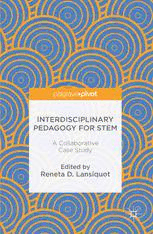
Interdisciplinary Pedagogy for STEM: A Collaborative Case Study PDF
Preview Interdisciplinary Pedagogy for STEM: A Collaborative Case Study
INTERDISCIPLINARY PEDAGOGY FOR STEM A Collaborative Case Study Edited by Reneta D. Lansiquot Interdisciplinary Pedagogy for STEM Reneta D. Lansiquot Editor Interdisciplinary Pedagogy for STEM A Collaborative Case Study Editor Reneta D. Lansiquot City University of New York New York City College of Technology Brooklyn, New York, USA ISBN 978-1-137-56744-4 ISBN 978-1-137-56745-1 (eBook) DOI 10.1057/978-1-137-56745-1 Library of Congress Control Number: 2016941867 © The Editor(s) (if applicable) and The Author(s) 2 016 This work is subject to copyright. All rights are solely and exclusively licensed by the Publisher, whether the whole or part of the material is concerned, specifi cally the rights of translation, reprinting, reuse of illustrations, recitation, broadcasting, reproduction on microfi lms or in any other physical way, and transmission or information storage and retrieval, electronic adaptation, computer software, or by similar or dissimilar methodology now known or hereafter developed. The use of general descriptive names, registered names, trademarks, service marks, etc. in this publication does not imply, even in the absence of a specifi c statement, that such names are exempt from the relevant protective laws and regulations and therefore free for general use. The publisher, the authors and the editors are safe to assume that the advice and information in this book are believed to be true and accurate at the date of publication. Neither the pub- lisher nor the authors or the editors give a warranty, express or implied, with respect to the material contained herein or for any errors or omissions that may have been made. Printed on acid-free paper This Palgrave Macmillan imprint is published by Springer Nature The registered company is Nature America Inc. New York To my loving partner, mom, dad, and sister, a public school teacher. Also to educators who team-teach, sharing their multiple perspectives with students. F OREWORD Imagine a student earning a bachelor’s degree in computer systems at your institution, going on to earn a PhD in educational communication and technology, returning to your institution as an assistant professor in the English Department, and within a few years, leading an initiative to expand interdisciplinary teaching and learning, which becomes a signature component of the college’s new General Education program. Such was the trajectory of Dr. Reneta D. Lansiquot, editor of this book, who fi rst approached me when I was serving as the dean of the School of Arts and Sciences with the idea of forming an Interdisciplinary Studies Committee to promote interdisciplinary curricular development. The introductory chapter, by Professor Reneta D. Lansiquot, traces her story, focusing on her experiences both as a student and as a faculty member. It also includes practical information on administrative issues, pedagogical approaches, and navigating institutional politics for those inspired to lead a similar initiative at their own institution. A college’s General Education program is that portion of the curricu- lum that all students share. It helps to defi ne an institution’s identity and represents a consensus on what students should know, value, and be able to do. The remaining chapters in this book demonstrate the depth and breadth of the interdisciplinary courses developed as part of this initiative and how they promote student’s critical thinking. In Chap. 2 , Philosophy Professor Laureen Park describes how students integrated various disciplinary perspectives in the interdisciplinary course, Weird Science: Interpreting and Redefi ning Humanity , using Hans Georg vii viii FOREWORD Gadamer’s notion of the sensus communis . Ways that students build on prior knowledge to integrate interdisciplinary concepts are highlighted. Economics Professor Sean P. MacDonald and Sociology Professor Costas Panayotakis analyze the concept of an insatiable human nature through a critique of traditional neoclassical economic assumptions about human behavior in Chap. 3 . Through a case study on the causes of the global economic and fi nancial crisis of 2008, MacDonald and Panayotakis argue that actions traditionally accepted by many as “natural” are actu- ally cultivated social mores. This activity challenges students to question assumptions that are presented as truths. Chapter 4 , by Library Science Professor Anne E. Leonard and Psychology Professor Jean E. Hillstrom, describes the development and content of the responsible conduct of research and information literacy modules, as well as discussing the role of each in an interdisciplinary course. Leonard and Hillstrom make a clear connection between interdis- ciplinary student learning outcomes related to skills, values, and construc- tivist theory. Professor Reneta D. Lansiquot and Computer Systems Technology Professor Candido Cabo describe the design, development, and teaching of an interdisciplinary course linking creative writing and computational thinking for non-computer majors in Chap. 5 . In this course, students cre- ate original stories and then implement them as a video game prototype using computer programming. Chapter 6 , written by Physics Professor Reginald A. Blake and Mathematics Professor Janet Liou-Mark, presents research fi ndings related to their work as principal investigators on National Science Foundation Research Experiences for Undergraduates (NSF REU) grants in the geo- sciences. Through undergraduate research, students actively and collab- oratively discover new knowledge while learning more about one of the most interdisciplinary scientifi c fi elds, the geosciences. Results indicate that geoscience research experiences increased the students’ understand- ing of the relevancy of their interdisciplinary study to society. In the last chapter, Professor Reneta D. Lansiquot and graduate stu- dent Tamrah D. Cunningham present a student’s perspectives of the unique challenges and distinct advantages of team-taught interdisciplinary courses. In summary, this book provides rich food for thought for educators, while providing a road map to those interested in adopting such a pro- FOREWORD ix ductive approach at their own institution. New York City College of Technology is proud of the accomplishments of Professor Lansiquot in her roles as both an alumni and faculty member. A ssociate Provost Pamela Brown New York City College of Technology Brooklyn, NY
